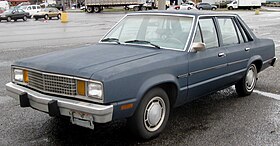Mercury Zephyr
| Ford Fairmont | |
|---|---|

1978-1980 Ford Fairmont four-door sedan
|
|
| Overview | |
| Manufacturer | Ford |
| Production | 1978–1983 |
| Assembly |
Claycomo, Missouri Mahwah, New Jersey St. Thomas, Ontario, Canada Valencia, Carabobo, Venezuela, Mexico (La Villa Assembly Plant) |
| Body and chassis | |
| Class | Compact |
| Body style | 2-door coupe 2-door sedan 4-door sedan 4-door station wagon |
| Layout | FR layout |
| Platform | Ford Fox platform |
| Related |
Mercury Zephyr Ford Durango |
| Powertrain | |
| Engine | 140 cubic inches (2.3 L) OHC I4 140 cubic inches (2.3 L) OHC I4 Turbo 200 cubic inches (3.3 L) Thriftmaster Six I6 255 cubic inches (4.18 L) Windsor V8 302 cubic inches (4.95 L) Windsor V8 |
| Transmission | 4-speed manual 3-speed C3 automatic 3-speed C4 automatic 3-speed C5 automatic |
| Dimensions | |
| Wheelbase | 105.5 in (2,680 mm) |
| Length | 193.8 in (4,920 mm) |
| Width | 71.0 in (1,800 mm) |
| Curb weight | 2,747–2,959 pounds (1,246–1,342 kg) |
| Chronology | |
| Predecessor |
Ford Maverick Mercury Comet |
| Successor | Ford Tempo / Mercury Topaz |
The Ford Fairmont is a compact car which was produced by Ford for the North American market in the 1978 to 1983 model years. Introduced as the successor to the Ford Maverick, the Fairmont was also sold by Lincoln-Mercury dealers as the Mercury Zephyr, replacing the Mercury Comet. The Fairmont and Zephyr were sold as two-door notchback sedans, two-door coupes, four-door sedans, and five-door station wagons.
The Fairmont and Zephyr marked the introduction of the long-running Ford Fox platform, used for a wide variety of later models. Those closely related to the Fairmont included the 1980–1988 Ford Thunderbird, the 1981–1982 Ford Granada, the 1980-1988 Mercury Cougar, the 1979–1993 Ford Mustang, 1979–1986 Mercury Capri, 1983-1986 Ford LTD, 1983-1986 Mercury Marquis, 1982–1987 Lincoln Continental and the 1984-1992 Lincoln Mark VII.
While retaining a conventional rear-wheel drive platform, the Fairmont was efficiently packaged and offered excellent passenger and cargo room for its size. Contemporary reviews uniformly praised the Fairmont and it was favorably compared with contemporary Volvo and BMW models. Rack-and-pinion steering gave the Fairmont much better handling and roadability than its Maverick predecessor and despite its roomier interior, lightweight components were used which gave the Fairmont better fuel economy than the Maverick.
As Ford switched to lighter, more aerodynamic cars with front-wheel drive in the 1980s, the Fairmont was replaced by the all-new Tempo for 1984.
...
Wikipedia
